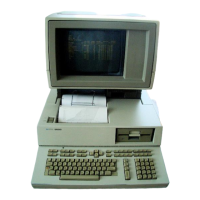Theory
of
Operation
2-27
When using the 1 Megabyte
RAM
boards, a unique feature
is
employed. The Ram boards are
interleaved for better efficiency
in
memory access. This interleaving means that consecutive addres-
ses are found on different 1 Megabyte boards. Interleaving can be between 2, 4, or eight boards.
Whenever 1 Megabyte boards are used they
will
be used
in
pairs so this feature can
be
utilized to
its
best advantage. The stack can support up to ten 1 Megabyte boards
and
the appropriate interleave
method for each configuration
will
be implemented automatically. If two boards are used,
all
the
odd
numbered addresses are on
one
board and the even numbered addresses are on the other
board. Consecutive addresses
will
alternate between the boards. If four boards are used, consecu-
tive addresses move from
one
board to the next. For example: address 0 may be on board one;
address 1 on board two; address 2 on board three; address 3 on board four;
and
address 4 on
board one; etc.
It
is
not necessary to change anything on the boards, as the operating system
automatically controls the set-up of interleaving for the best operation of the computer regardless of
the number of
RAM
boards or the mixture of 256K, 512K, or 1 Megabyte boards. Mapper
CAM
data bits 9, 10,
and.
11 are used to ensure that the mapper
CAM
responds to the correct interleave
method implemented by the operating system.
Even with the interleaving, the program speed of the 1 Megabyte
RAM
boards may be slightly
slower on some programs, when compared to the program speed using the 256K or 512K
RAM
boards. This
is
due to the slower access time of the 1 Megabyte
RAM
boards.
Error Detection and Correction
As
in
the other memory boards, the Memory Controller detects and corrects single bit errors
in
data
read from
RAM.
It
also detects double bit errors. Each
32
bit word written to memory has a 7 bit
Hamming code attached to
it.
When the data word
is
read, a single bit or double bit error
is
detected.
Any single bit error that
is
detected
is
automatically corrected before the word
is
transferred to the
MPB.
No additional time
is
required for the correction.
At
the same time that a single bit error
is
detected and corrected, the correct data
is
written into a healer location.
A double bit error
is
detected but not corrected. A double bit error causes the system to halt,
preventing continuation of a program with
bad
data.
Memory Healing
Each Memory Controller contains
32
words each of
CAM
and
RAM
which are used to replace
up
to
32
failed memory words (Figure 2-18). The physical address of a failed word
is
put
in
the healer
CAM,
and
the corrected data
is
put
in
the corresponding healer
RAM
location.
Bit
0 in the
CAM
is
set to enable the address to be matched. Subsequent accesses to this physical address are to the
healer
RAM
instead
of
the failed memory, causing the healer word to replace the failed word.
Healing does not affect the timing of the memory operation. Except for the healer,
no
record of
healing
is
stored
in
memory.
All
mapped addresses are sent to the healer
CAM,
which compares each mapped address to
all
addresses of failed locations.· Healer
CAM
addresses of failed locations have bit 0 set.

